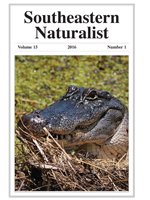Reproductive biology and early life-history data are important for understanding the ecology of fishes. In 2008, we conducted captive propagation studies on 3 species of darters of the subgenus Nothonotus: Etheostoma wapiti (Boulder Darter), E. vulneratum (Wounded Darter), and E. maculatum (Spotted Darter). The length of spawning period and associated range of water temperatures for the Wounded Darter exceeded that of the Spotted Darter and Boulder Darter. The mean number of eggs produced per female was lowest for Boulder Darter and highest in the Wounded Darter. The Boulder Darter had the highest percent of eggs hatched, the lowest percent larval to juvenile stage survivorship, and the lowest mean number of juveniles produced per female. Egg diameters at deposition and prior to hatch were smallest for the Spotted Darter. If reproductive biology and early lifehistory information from captive fishes represent that of wild populations, then the data obtained during this study are relevant to development and implementation of conservation and management plans for these closely related darter species.
How to translate text using browser tools
1 March 2016
Captive Propagation, Reproductive Biology, and Early Life History of Etheostoma wapiti (Boulder Darter), E. vulneratum (Wounded Darter), and E. maculatum (Spotted Darter)
Crystal L. Ruble,
Patrick L. Rakes,
John R. Shute,
Stuart A. Welsh
ACCESS THE FULL ARTICLE

Southeastern Naturalist
Vol. 15 • No. 1
March 2016
Vol. 15 • No. 1
March 2016




